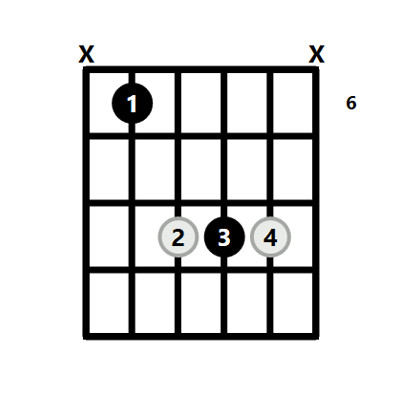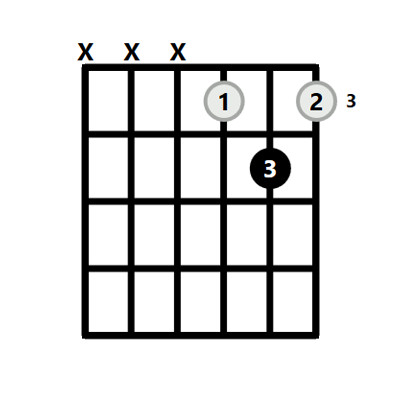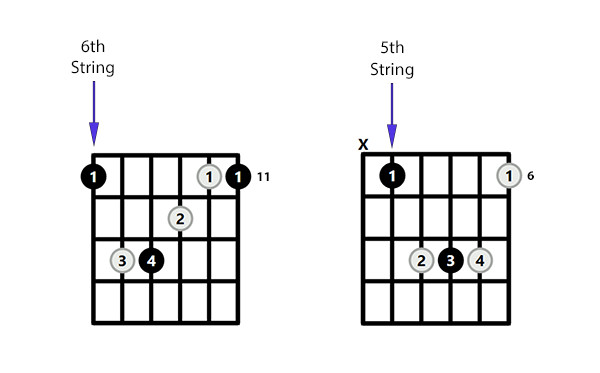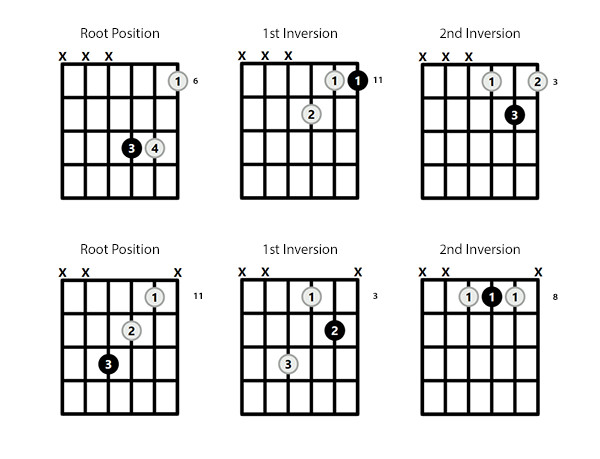The E flat major chord, often referred to as the Eb guitar chord, is a foundational element in guitar playing. From beginner lessons to advanced compositions, the Eb chord appears across diverse musical styles. Understanding how to play it in various positions and knowing its theoretical underpinnings will significantly enhance your guitar skills and musical vocabulary.
Delving into E Flat Chord Theory
To truly master the Eb guitar chord, it’s crucial to understand the music theory behind it. Let’s break down the essentials:
- Chord Composition: The Eb Major chord is built from three notes: Eb, G, and Bb.
- Scale Derivation: This chord is derived from the E Flat Major scale, utilizing the 1st (root), 3rd, and 5th degrees of the scale.
- Interval Structure: Like all major chords, the Eb Major chord follows a specific interval pattern from its root note: Major 3rd, minor 3rd, and Perfect 4th (returning to the root note).
- Key Significance: The Eb Major chord is the tonic chord (the first and most important chord) in the key of Eb Major. The complete set of chords in the key of E flat Major are Eb Major, F minor, G minor, Ab Major, Bb Major, C minor, and D diminished.
Understanding these theoretical aspects provides a deeper connection to the chord and its role in music.
10 Essential Ways to Play the Eb Major Chord
Visualizing chord shapes is key to learning guitar. Here are 10 diagrams illustrating different ways to play the Eb Major chord across the fretboard:
 Eb Major Chord – 10 Shapes
Eb Major Chord – 10 Shapes
Let’s explore some of the most practical and common Eb chord shapes in more detail:
The Standard Eb Guitar Chord Shape
The most frequently used Eb chord shape is rooted in the ‘root-5’ barre chord form, typically played starting at the 6th fret. Often, guitarists will play a variation where the index finger doesn’t fully barre across all strings but focuses on pressing down the root note on the 6th string.
 Eb Chord Guitar
Eb Chord Guitar
The Easy Eb Chord Shape for Beginners
For guitarists who find barre chords challenging, the ‘easy’ Eb chord shape offers a simpler alternative. This version utilizes only the top three strings. It’s essentially the same shape as an open D chord, but shifted up one fret and without playing the open D string. This makes it a great entry point for incorporating the Eb chord into your playing.
 Easy Eb Chord Guitar
Easy Eb Chord Guitar
Step-by-Step Guide to Playing the Standard Eb Chord
For those who learn best with detailed instructions, here’s a step-by-step breakdown of the standard Eb Major chord shape:
- Index Finger Placement: Place your first finger on the 6th fret of the 5th string (A string).
- Middle Finger Placement: Place your second finger on the 8th fret of the 4th string (D string).
- Ring Finger Placement: Place your third finger on the 8th fret of the 3rd string (G string).
- Pinky Finger Placement: Place your fourth finger on the 8th fret of the 2nd string (B string).
- Strumming: Avoid strumming the 6th string (low E string) and strum downwards across the remaining five strings (from the 5th string down to the 1st string).
Following these steps methodically can help you ensure you are correctly forming the most common Eb Major chord shape, especially if you are visually misinterpreting the chord diagram.
Utilizing Barre Chords for E Flat
The Eb chord is readily playable as a barre chord, providing movable shapes up and down the guitar neck. You can use two primary barre chord shapes to play Eb:
- Root 6 Barre Shape: Employ the ‘E shape’ barre chord starting on the 11th fret. This shape gets its name because the root note is on the 6th string.
- Root 5 Barre Shape: Use the ‘A shape’ barre chord beginning on the 6th fret. This shape is named because its root note is located on the 5th string.
These barre chord shapes are invaluable for smoothly transitioning between Eb and other chords in different keys and positions.
 Eb Barre Chord Guitar
Eb Barre Chord Guitar
Exploring Eb Major Triads
While barre chords are common for playing the Eb chord, understanding triads offers another dimension. Triads are three-note chords and are essential for understanding chord construction and creating interesting voicings. The Eb Major triad can be voiced in three inversions:
- Root Position: Eb – G – Bb (root, 3rd, 5th)
- 1st Inversion: G – Bb – Eb (3rd, 5th, root)
- 2nd Inversion: Bb – Eb – G (5th, root, 3rd)
Here are visual representations of six different Eb Major triad voicings, including inversions, on the guitar:
 Eb Major Triad Guitar
Eb Major Triad Guitar
Musical Keys Featuring the Eb Chord
Knowing which keys naturally include the Eb chord is essential for songwriting and improvisation. The Eb chord is a diatonic chord in several keys:
- Key of Eb Major: Eb Major is the tonic chord, naturally present along with F minor, G minor, Ab Major, Bb Major, C minor, and D diminished.
- Key of Bb Major: Eb Major functions as the IV chord in Bb Major, alongside Bb Major, C minor, D minor, F Major, G minor, and A diminished.
- Key of Ab Major: Eb Major is the V chord in Ab Major, appearing with Ab Major, Bb minor, C minor, Db Major, F minor, and G diminished.
- Key of C minor: Eb Major is the III chord in C minor, found with C minor, D diminished, F minor, G minor, Ab Major, and Bb Major.
- Key of G minor: Eb Major is the VI chord in G minor, present with G minor, A diminished, Bb Major, C minor, D minor, and F Major.
- Key of F minor: Eb Major is the VII chord (often functioning as a flattened VII) in F minor, alongside F minor, G diminished, Ab Major, Bb minor, C minor, and Db Major.
Alternative and Useful E Flat Chord Shapes
Beyond the standard shapes, several alternative Eb chord voicings can add color and interest to your playing. While not as common as the standard shapes, these are valuable additions to your chord vocabulary. Explore different inversions and partial chord shapes to discover unique sonic textures.
Eb Chord Substitutions
In many musical contexts, you can substitute the Eb chord with related chords to create variations and harmonic interest. Common substitutions for Eb Major include:
- Eb sus4: Suspended 4th chords add a floating, unresolved quality.
- Eb sus2: Suspended 2nd chords offer a brighter, more open sound.
- Eb add9: Add 9 chords create a richer, more complex major sound.
Conversely, the Eb Major chord itself can sometimes act as a simplified substitute for more complex chords like Eb Major 7, Eb7, and other extended chords that have Eb as the root. However, it’s important to note that Eb Major cannot typically substitute for minor chords.
Scales for Soloing and Improvising Over the Eb Chord
To effectively solo or improvise over an Eb Major chord, or to write melodies that complement it, certain scales are particularly well-suited:
- Eb Major Scale: The most fundamental choice, perfectly outlining the chord tones.
- Eb Mixolydian Mode: A major scale with a flattened 7th, creating a bluesier, dominant feel.
- Eb Dorian Mode: A minor scale with a major 6th, offering a minor tonality with added color.
- Eb Blues Scale: Essential for blues and rock improvisation over the Eb chord.
- Eb Pentatonic Major Scale: A simplified major scale, great for melodic phrasing.
Experimenting with these scales will unlock creative possibilities for your lead guitar playing over the Eb chord.
Further Exploration
To deepen your understanding of guitar chords and expand your chord vocabulary, consider exploring resources like “Guitar Chords Galore,” which offers comprehensive chord diagrams and lessons.
 Get Guitar Chords Galore eBook
Get Guitar Chords Galore eBook
Promotional image for a guitar chords ebook, inviting readers to further their chord knowledge and guitar learning journey.
By mastering the Eb guitar chord in its various forms and understanding its theoretical context, you’ll significantly enhance your guitar playing and musical expression. Practice these shapes, explore the theory, and experiment with the scales and substitutions to truly unlock the potential of the Eb chord in your music.
